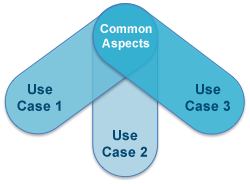Institute for Telecommunication Sciences / Research / Quality of Experience / Video Quality Research / Public Safety / VQiPS Resources / Guide to Defining Video Quality Requirements / Video Use Classes
VQiPS Use Classes
Use cases for seemingly different tasks have similar quality requirements. That is, upon closer examination, seemingly disparate video use cases may actually have the same minimum requirements to perform a desired recognition task.
While your use cases may seem unique, they almost certainly share features common to other use cases. For example, license plate identification and monitoring wildfires seem to be very different use cases on the surface, and they are in fact very different in many regards. However, they have many common minimum video requirements.
Description

You can develop performance specifications more easily for a finite set of generalized use classes. By defining use cases as belonging to a generalized use class you eliminate the need to generate separate performance specifications for every possible use case.
By answering just a few questions about your use cases, you can identify generalized use classes. The questions identify the intended use of the video and help determine the common aspects of use cases such as target size, motion, lighting level, usage timeframe, and discrimination level. The answers help you to form generalized use classes that describe your video quality needs.
-
Learn about generalized use class aspects.
